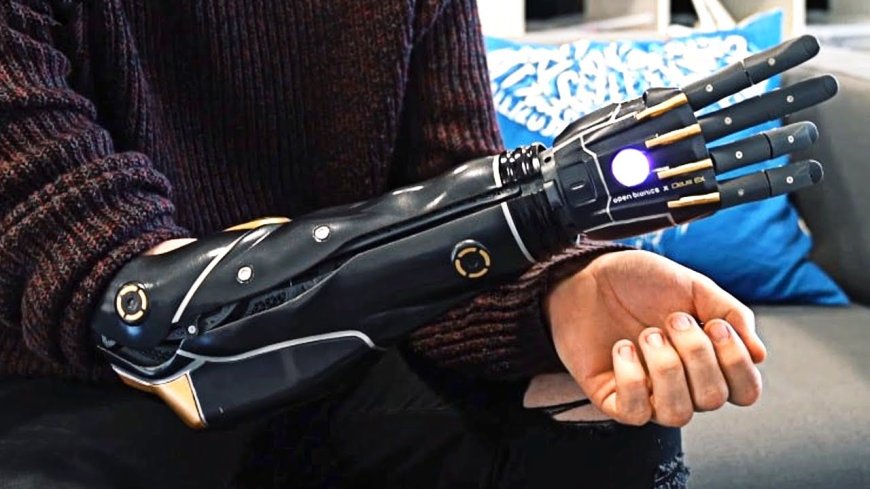Bionic Limbs with AI: The Future of Prosthetics is Here
Discover how AI is revolutionizing bionic prosthetics, creating mind-controlled limbs with real-time sensory feedback and adaptive learning.

How AI is Revolutionizing Bionic Limbs for a More Human-Like Experience
Imagine losing a limb but gaining one that moves and responds almost like the real thing—powered by artificial intelligence (AI) and advanced robotics. This is no longer science fiction. The world of bionic prosthetics is evolving at an unprecedented pace, and AI is at the heart of this transformation.
From mind-controlled arms to self-learning robotic legs, AI-driven bionic limbs are offering amputees not just mobility but true restoration of function, touch, and independence. Could this be the next leap in human augmentation? Let’s explore how AI is reshaping the future of prosthetics.
What Are AI-Powered Bionic Limbs?
Bionic limbs are robotic prosthetic devices that replicate the function of a natural limb. Unlike traditional prosthetics, which rely on mechanical movement, AI-powered bionic limbs use sensors, machine learning, and neural interfaces to create a seamless human-machine connection.
These advanced prosthetics can:
✅ Read muscle signals to predict movements in real time
✅ Adapt to different environments like stairs, uneven terrain, and slopes
✅ Provide sensory feedback, allowing users to feel pressure and texture
✅ Improve over time by learning from the user’s movement patterns
This level of intelligence and adaptability was unthinkable just a decade ago. But thanks to AI, bionic limbs are now more intuitive and lifelike than ever before.
How AI is Transforming Bionic Prosthetics
The integration of AI in bionic limbs is revolutionizing mobility in three key ways:
1. Mind-Controlled Prosthetics
Researchers are developing brain-computer interfaces (BCIs) that allow users to control prosthetics with their thoughts. By connecting AI-powered bionic limbs to the nervous system, users can move their prosthetic hands, fingers, and legs as naturally as they would a biological limb.
One groundbreaking innovation comes from Neuralink, Elon Musk’s neurotechnology company, which is developing brain implants that could one day allow users to control robotic limbs with just a thought (source).
2. AI-Powered Sensory Feedback
One of the biggest challenges in prosthetics has been the lack of sensation. But new AI-powered bionic limbs, like those developed by Ossur and Open Bionics, use electrical signals and machine learning to provide real-time touch feedback.
This means users can feel textures, pressure, and even temperature, making the prosthetic feel more like a natural limb.
A study published in Science Robotics showed that AI-enhanced prosthetics with sensory feedback significantly improve user experience and confidence (source).
3. Adaptive and Self-Learning Bionic Limbs
Traditional prosthetics require manual adjustments, but AI-driven prosthetics can learn and adapt automatically. For example:
- Ottobock’s AI-powered C-Leg adjusts to the user’s gait, providing stability on different terrains (source).
- The LUKE Arm, developed by DEKA Research, mimics natural hand movements using machine learning (source).
These innovations mean less effort for the user and more natural movement.
Breakthroughs in AI Bionic Prosthetics
1. The World's First AI Bionic Hand
A UK-based company, Covvi, has developed a bionic hand that connects to the cloud. This allows users to update their prosthetic's AI software remotely, making it smarter over time (source).
2. The "Smart Leg" That Thinks for Itself
MIT researchers are developing AI-driven robotic legs that can predict and adapt to movements, allowing amputees to walk more naturally. Their machine learning algorithms help the prosthetic leg respond instantly to walking patterns (source).
3. AI-Powered Exoskeletons for Enhanced Mobility
AI isn’t just improving prosthetics—it’s also enhancing exoskeleton technology. Companies like Ekso Bionics are creating robotic exoskeletons that help paralyzed individuals walk again (source).
Challenges and Ethical Considerations
While AI-powered bionic limbs are game-changing, they come with challenges:
? Cost – High-end AI prosthetics can cost upwards of $50,000, making them inaccessible to many.
? Data Privacy – AI prosthetics collect biometric data, raising concerns about privacy and security.
? Human Enhancement vs. Medical Necessity – As AI-driven prosthetics become more advanced, there’s debate over whether they should be used for medical recovery or human augmentation.
Despite these hurdles, experts believe continued innovation and cost reduction will make AI-powered bionics more widely available.
The Future of AI-Powered Bionic Limbs
So, what’s next? In the coming years, we can expect:
? Affordable, mass-produced AI prosthetics
? Prosthetics that connect directly to the brain, eliminating delays
? Smart limbs with real-time haptic feedback, making them indistinguishable from natural limbs
With companies like Neuralink, Open Bionics, and MIT leading the way, the dream of fully functional, AI-powered bionic limbs is closer than ever.
Conclusion: The Dawn of a New Era in Prosthetics
AI-powered bionic limbs are breaking barriers, offering amputees a level of control, functionality, and independence that was once impossible. With AI, prosthetics are no longer just replacements—they’re becoming extensions of the human body.
As technology advances, we may soon see bionic limbs that are better than natural ones, raising profound questions about the future of human augmentation. Could AI-enhanced prosthetics lead to a world where humans upgrade their limbs voluntarily?
One thing is clear: the future of prosthetics is intelligent, adaptive, and more human than ever before.
What's Your Reaction?
 Like
0
Like
0
 Dislike
0
Dislike
0
 Love
0
Love
0
 Funny
0
Funny
0
 Angry
0
Angry
0
 Sad
0
Sad
0
 Wow
0
Wow
0



















































